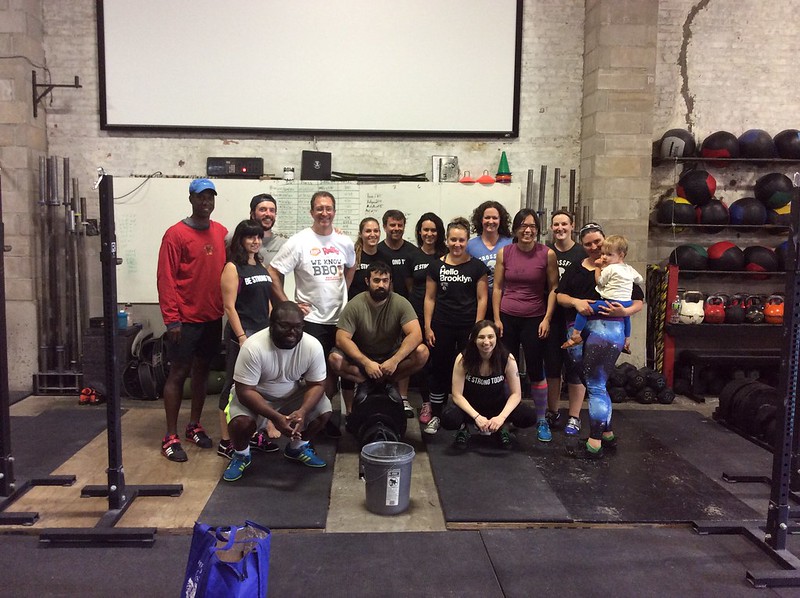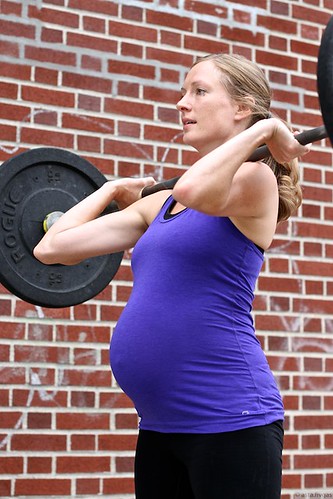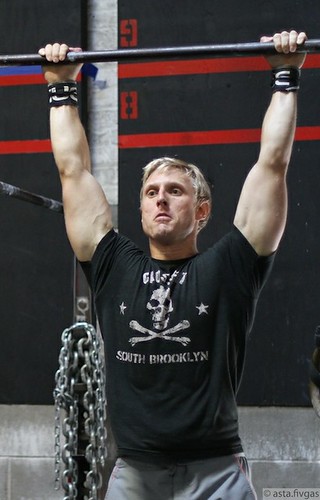Bethany’s Mother’s Day CrossFit Total
CrossFitting While Pregnant: An Interview with Four Women and a Coach, Part 1
By Kate Reece
Over the last couple years, the CrossFit blogosphere has exploded with articles about pregnancy and CrossFit. Beyond the typical and legitimate concerns about what is “safe,” many women who become pregnant while CrossFitting often find themselves lost in a sea of conflicting information—not just on the Internet, but also from their doctors and other well-intentioned friends and family members with strong opinions. In the interest of caring as well for CFSBK’s community of women and parents as possible, we decided to enter the conversation from our perspective and experience, and gather as many resources as possible for anyone who is training with us and becomes pregnant.
Our approach is simple, and acknowledges that everyone’s experience is different—and that the most important thing is listening to your body. We talked to four CFSBK members who became pregnant during their training: Bethany E., Noor A., Courtney S., and Ellie M. We also interviewed Coach Fox about CFSBK’s guidelines for training women who are pregnant (available here).
We got such great information from these women and Coach Fox that we’ve broken the article into three parts, which we’ll post over the next three weeks. There will also be an article on ITA soon.
CFSBK: Tell us about your training history before you became pregnant, or where your CrossFit journey intersected becoming a mom. Did you already have a child before you started CrossFitting?
Bethany E.: When I became pregnant with my first child, Alex, I had been CrossFitting for about four years already, and was a few weeks into my second consecutive Strength Cycle with Coach Jeremy. Two years later when I became pregnant with my second son, Oscar, I was a week or two into my fourth Strength Cycle.
Noor A.: I was CrossFitting for about three years before I became pregnant—the intensity of the workouts were a perfect antidote for the stress of law school. The game plan between my husband, Samir, and me was to make a baby while I was in school, and for me to start Coach Jeremy’s Strength Cycle while we were working on it. By the time I started Strength Cycle, there were already two or three other pregnant women who had gone through at least one eight-week cycle, so I figured it couldn’t hurt to give the “Squat Whisperer” a try.
Courtney S.: I started CrossFit in April of 2011 when I moved from San Francisco to New York. In June of 2012 my box started, and I participated in, a competition team for those who were interested in CrossFit training at a competitive level. We trained two-plus hours a day, five days a week. I trained with the team until I moved to Brooklyn this past September. My first child, Hannah, was born October 4, 2013.
Ellie M.: I started doing CrossFit-type workouts sometime in 2008 when I lived in Virginia with McDowell. I followed the main site programming, with everything scaled beyond recognition, but I enjoyed it, and was able to start building skills just by reading, watching videos, and winging it. I took Foundations at CFSBK when we moved to Brooklyn in August of 2011. For the past two years, I’ve focused on training and learning, participating in random local competitions, and just having fun with it.
CFSBK: What was your reaction to finding out you were pregnant in the context of your training?
Bethany E.: Delight and an even stronger commitment to my physical health and consistent training for the duration of my pregnancy. I have non-insulin dependent diabetes, and was well aware of how carefully (i.e. medically) diabetic pregnancies are treated. I wanted to have the most low-key pregnancy possible and a natural, unmedicated delivery, and knew that training would help me achieve that.
Noor A.: After years of trying not to get pregnant, Samir and I assumed that the minute we actually consciously tried to make a human it would happen. Not so much. To spare you the details, I was pretty psyched when I finally realized I was pregnant. I was in the middle of my second strength cycle at the time, and felt pretty good overall. More than anything, the forced abstention from alcohol and caffeine probably did me a lot of good, because if I remember correctly, I was pretty happy with my Total.
Courtney S.: I knew that to the extent I had a healthy and low-risk pregnancy that I would continue to CrossFit throughout my pregnancies. I found out I was pregnant with Hannah two months prior to the 2013 Open. I honestly didn’t expect to get pregnant so quickly, and although I was ecstatic that it happened right away I was (secretly) a little bummed that I wouldn’t be able to help the team qualify for Regionals. I actually think I napped in the corner of the gym during the Open workouts that year.
Ellie M.: I was so excited to be pregnant. I knew it would be a big change, and I kind of looked forward to slowing down and focusing on something different for a while. Gwen Stefani once said, “I imagine my children will save me from my vanity.” (Who knew I’d ever be quoting Gwen Stefani’s maternal wisdom?) I like this quotation, because becoming a parent means sacrificing your vanity, and women certainly experience that when they see their bodies and training change so dramatically.
CFSBK: Did you seek out resources or advice from our coaches or other coaches about how to proceed? What was some of the best or most resounding advice you received/learned about how to proceed?
Bethany E.: Because I was enrolled in Strength Cycle at the time, Coach Jeremy was the first person after my immediate family to know about both of my pregnancies! We both did our research and didn’t find a whole wealth of information on pregnancy and powerlifting specifically. There is a lot of good info on CrossFitting and pregnancy so that was a good start. We decided to just take it a session at a time and use common sense and listen to my body. The best advice I’d read was exactly that: use some common sense, protect your belly and abs from diastasis (no sit-ups!), stay cool and hydrated, and in general just listen to your body. There is a great forum on BabyCenter.com called “BBC Crossfit Moms” that I found helpful.
Noor A.: My mother’s a doctor, and … I knew many women who were cautioned against doing anything by their doctors while pregnant. … [I was skeptical of] medical advice regarding working out and pregnancy, [so] I decided to use the more unscientific approach of asking around, checking out blogs, and listening to my own body when it came to working out. Of course, I was aware of certain changes to look out for, such as the effect of the hormones relaxing my ability to maintain proper form on my squats, or problems that could arise if I were dehydrated or overheated. I don’t consider myself to be an overly competitive person, so I wasn’t too worried about overdoing it.
My general principle was to keep coming to the gym, to keep moving, and to do things at a pace where I felt good and stayed in proper form. The best advice I got was from other moms, who told me to make sure I could always keep up a conversation while doing any WOD, and those who taught me to adjust my stance in my squats, or in my rowing, to make room for my growing belly.
Courtney S.: Oddly enough, I was only the second member at our box, and the first who was training competitively, to become pregnant. As a result, my coaches—who were the first people to find out I was pregnant outside of my immediate family—and I did a lot of experimenting with modifications and substitutions throughout the different stages of my pregnancy. Learning to think creatively and modify workouts within the context of my pregnancy was not only fun, but allowed me to do many of the workouts up until the last weeks of my pregnancy (Barbara at 37 weeks—yup!), and also allowed me to continue to train with the team as opposed to doing totally different workouts off on my own.
Aside from seeking advice from my coaches whenever I had a question or needed inspiration, my main focus was to simply listen to what my body was telling me felt okay on each particular day I made it to the gym. Although it sounds simple, that was the most important lesson that I learned during my pregnancy: to listen to my body on a day-by-day, movement-by-movement basis. What felt good one day often did not feel good the next, so I would try to focus in the moment and not push too much or have too many expectations about what I should or could be doing.
Ellie M.: I read a lot online, seeking a story like mine. I wanted to hear about another experienced CrossFitter who kept it up throughout pregnancy, and find out how it felt, how it benefitted the pregnancy, what’s possible, etc. I know that relying on the voices of the Internet can be tricky—I had to navigate my way around a wide spectrum of opinions and experiences. But basically, I knew deep down this was something I wanted to try. I never discussed CrossFit with my doctor.
The biggest challenge is all the conflicting information. You see guidelines that tell you not to go upside down or lie on your back during the second trimester, but find that those movements still feel just fine, and that your handstands are actually better than ever! Or you’ll see videos or photos of pregnant women in their third trimesters doing muscle ups. It’s hard to determine what’s safe.
The best advice I received came from CFSBKer Kristin H., who told me that from her experience training pregnant women, she learned that exercising while pregnant is a deeply personal and relative experience for each woman. We decide what is best for us and what we feel safe doing. That might seem obvious, but with a first time pregnancy, you are seeking some kind of blanket advice to help steer your actions, and the truth is, this is it. The best thing you can do is take it one day at a time, listen to your body, and put your vanity aside.
CFSBK: Coach Fox, how do you respond, as a coach, when a CFSBKer tells you she is pregnant? What resources do you point them to?
Coach Fox: Usually a smile and a hug or high-five first. Then if I don’t know already, I’ll ask if it’s their first kid, and how they’ve been feeling. I’d explain many of the things we included in our new internal guide—explaining what to expect in the beginning, and how things change in the second and third trimester. CrossFit as a whole obviously supports women working out while they’re pregnant, but I can only speak from my experience training pregnant women and doing research. All the useful information is common sense—how does it feel? If it doesn’t feel good, don’t do it. I tell women not to ever be afraid to scale something, ask if they’re not sure, and to look at the next nine months as maintaining a level of fitness. You’re not going to be coming in and crushing workouts.
We’ll be back next week, with Part Two!
News and Notes
- ATTENTION FIGHT GONE BAD COMPETITORS! Teams need to reply to their welcome email with the name of their team captain ASAP. Team captains will then receive a separate email with details on how to set up their fundraising page, invite their teammates, and start fundraising! Also, if anyone got assigned to multiple teams, email Info [at] CrossFitSouthBrooklyn.com ASAP!!! We’re also still accepting registrations for anyone that missed the boat but still wants to participate.
- People’s Climate March is this Sunday, September 21! The March takes place two days before the UN meets to decide on key issues regarding climate change. If you are interested in participating in the March (which starts on the west side of Central Park), CFSBKer Keith F.would love if you’d join him. First, sign up here, then email him at keithrfr [at] gmail.com.
_____________________
The Learning Myth: Why I’ll Never Tell My Son He’s Smart Khan Academy
Pumping Iron in Cuba: Arien Chang Reveals an Underground Scene National Geographic
Introducing Brooklyn’s Threes Brewing, on 333 Douglass Street around the corner from CFSBK










